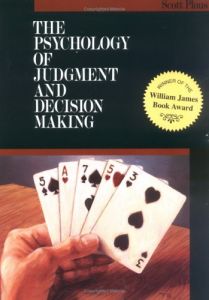
The Psychology of Judgment and Decision Making
Recommendation
Making the right decisions is seldom easy. Situations change and choices confound. Faulty perceptions and biases can block clear thinking and undermine the ability to weigh alternatives rationally. As U.S. Supreme Court Justice Benjamin N. Cardozo explained 90 years ago, “We may try to see things as objectively as we please. Nonetheless, we can never see them with any eyes except our own.” This is the vexing paradox involved in making decisions: People who are in the process of deciding cannot always trust their own perceptions and thought processes. Psychologist Scott Plous, winner of numerous awards and honors, examines decision making in this rigorously scientific yet mostly accessible book, itself an award winner. getAbstract believes it will interest decision analysts, researchers, psychologists and strategists, as well as readers who want to know why they may make poor decisions and how to make better ones.
Summary
About the Author
Psychologist Scott Plous, Ph.D., a business and political consultant, teaches psychology at Wesleyan University in Connecticut. Winner of a MacArthur Foundation “genius” grant, he has studied the psychology of the nuclear arms race, and ethical issues about animals and ecology.







Comment on this summary